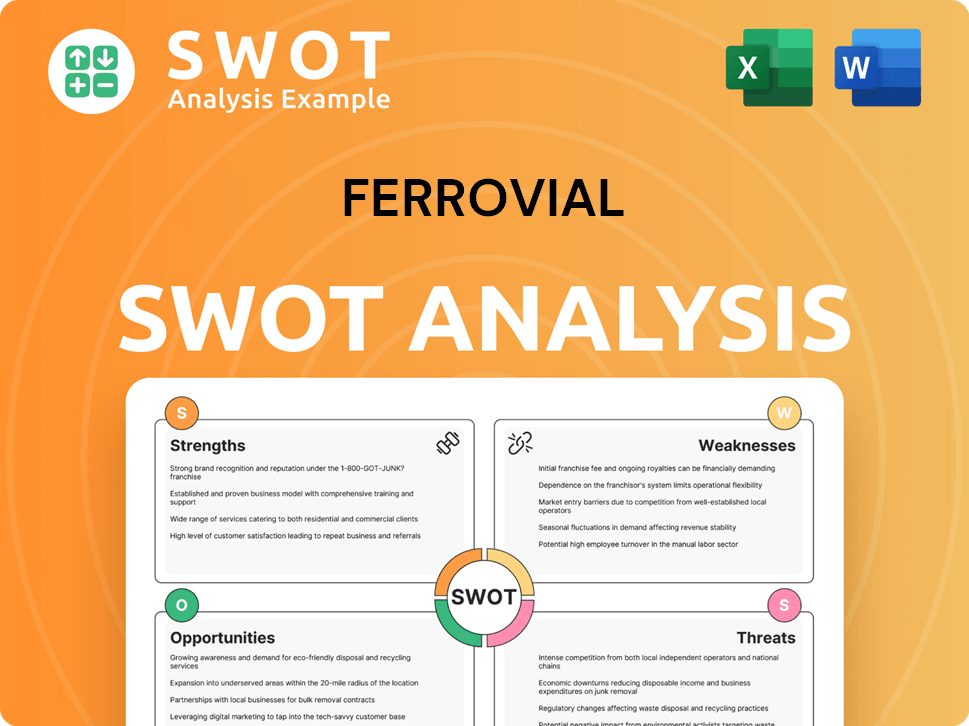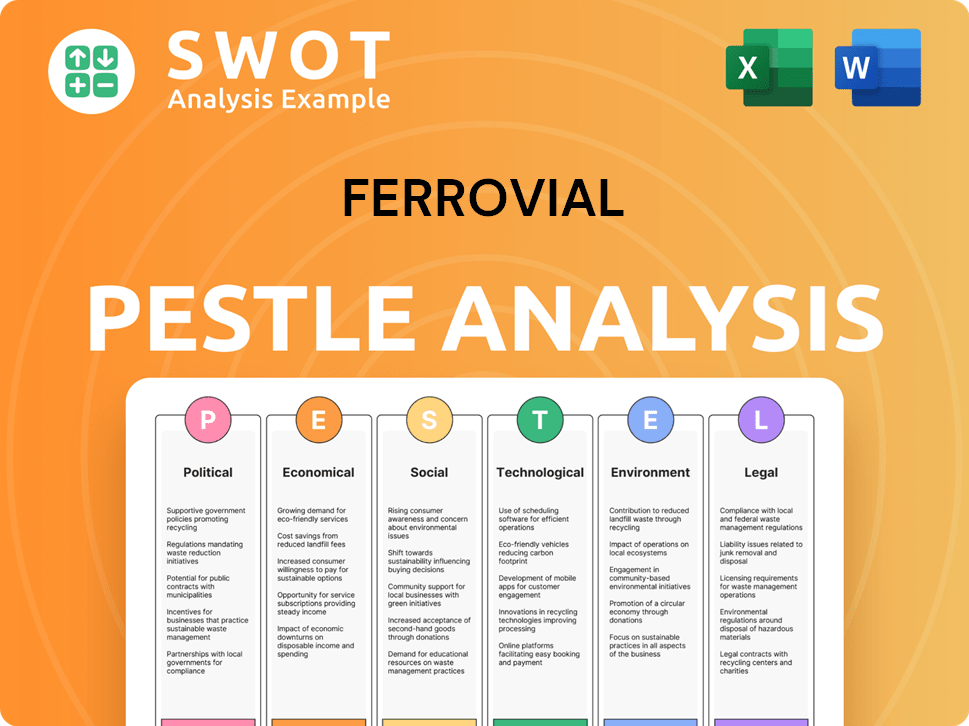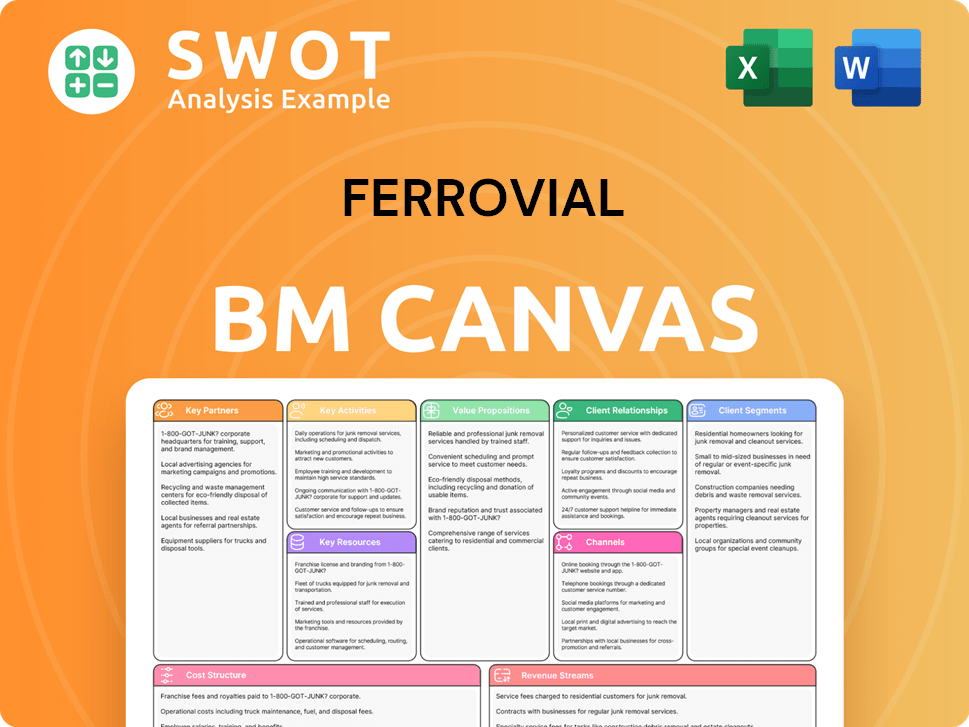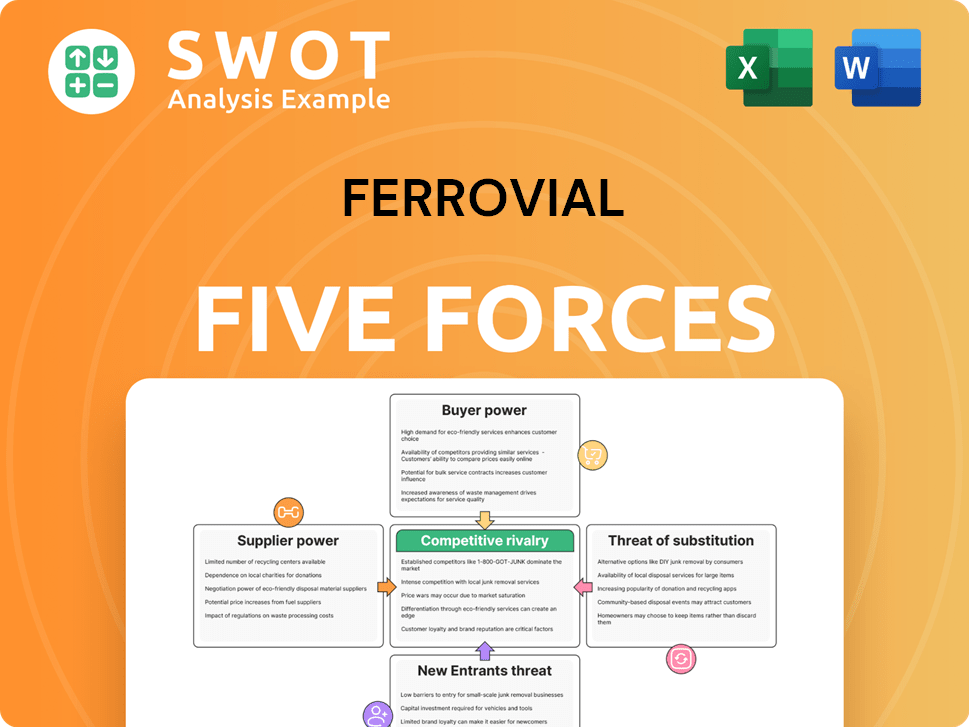Ferrovial Bundle
How Does Ferrovial Conquer the Global Infrastructure Market?
Founded in 1952, Ferrovial has transformed from a construction firm into a global infrastructure powerhouse. Its strategic listing on the Nasdaq in May 2024 signaled a major shift, particularly focusing on the lucrative US market. Understanding Ferrovial's Ferrovial SWOT Analysis is crucial to grasp its sales and marketing dynamics.

This exploration of Ferrovial's sales and marketing approach will uncover how the company leverages its integrated business model to secure a competitive advantage. We will analyze its sales process optimization, marketing campaign examples, and brand positioning strategy to understand its success. Furthermore, we'll examine Ferrovial's market analysis and digital marketing initiatives, revealing the strategies behind its impressive global footprint and sustained growth in the infrastructure sector, including its international marketing strategy.
How Does Ferrovial Reach Its Customers?
The sales channels of Ferrovial are primarily business-to-business (B2B), focusing on securing large-scale infrastructure projects. Their approach involves direct engagement with governments, public authorities, and private entities. This Ferrovial sales strategy is centered around the entire infrastructure lifecycle, from design and construction to financing and operation.
Ferrovial's integrated business model allows it to offer comprehensive solutions. This model is a key aspect of their Ferrovial business model. The company uses direct sales teams that participate in complex bidding processes and negotiations, particularly for public-private partnerships (PPPs).
The company's sales strategy has evolved to include a strong emphasis on internationalization. Ferrovial has a significant presence in key geographical areas, including the United States, the United Kingdom, Canada, Spain, Australia, and Poland. This expansion is often achieved through strategic acquisitions and alliances.
Ferrovial secures projects through direct engagement in tenders and concessions. This involves bidding for infrastructure projects, such as roads, airports, and other public works. The company's success in these tenders is crucial for its revenue generation.
The company engages in strategic asset rotation, selling mature assets to reinvest in new growth opportunities. This approach allows Ferrovial to optimize its portfolio and focus on high-growth areas. For example, in December 2024, they sold a portion of their stake in Heathrow.
Ferrovial focuses on expanding its presence in key international markets. This includes the United States, the United Kingdom, Canada, Spain, Australia, and Poland. This geographic diversification helps mitigate risk and capture growth opportunities.
Listing on the Nasdaq Stock Exchange in May 2024 enhanced Ferrovial's access to global capital markets. This supports the company's ability to finance and secure large-scale projects. This is an indirect channel supporting its growth.
Ferrovial's Ferrovial marketing strategy involves direct sales teams and strategic partnerships. They focus on securing large infrastructure projects through tenders and concessions. Their approach includes international expansion and strategic asset rotation, as well as financial market presence.
- Direct Engagement: Direct sales teams handle complex bidding and negotiations.
- Internationalization: Expansion through strategic acquisitions and alliances.
- Asset Rotation: Selling mature assets to fund new growth opportunities.
- Financial Markets: Accessing capital through stock exchanges to support project financing.
Ferrovial SWOT Analysis
- Complete SWOT Breakdown
- Fully Customizable
- Editable in Excel & Word
- Professional Formatting
- Investor-Ready Format

What Marketing Tactics Does Ferrovial Use?
The marketing tactics employed by Ferrovial are designed to boost brand awareness, generate leads, and solidify its position as a global leader in sustainable infrastructure. A key focus is on digital channels, recognizing their importance in engaging with stakeholders. This approach is central to the company's overall Ferrovial sales strategy and Ferrovial marketing strategy.
Ferrovial's approach includes a strong emphasis on content marketing, digital platforms, and data-driven strategies. These tactics are designed to support its strategic focus on sustainable and innovative infrastructure. The company also uses traditional methods, such as investor relations events, to engage with stakeholders. Understanding the Ferrovial strategy is key to grasping its market approach.
The company's commitment to digital marketing is evident in its comprehensive content marketing strategy and active social media presence. Through these efforts, Ferrovial aims to build its brand and engage with its target audience effectively. This digital transformation is a critical component of its Ferrovial sales and marketing approach.
Ferrovial's content marketing strategy is highlighted by its 'Brand Journalism' approach, featuring a relaunched corporate blog. This blog uses a fresh, personal style to engage readers. The company actively manages its presence on platforms like Twitter, Facebook, LinkedIn, and Instagram, in both Spanish and English.
A new TikTok profile has been created to reach a younger audience with dynamic content, aiming to grow social media communities. These efforts support the company's image in strategic mobility and innovation sectors. The company focuses on organic positioning through keyword studies and active community listening.
Ferrovial leverages data-driven marketing, using machine learning for dynamic pricing in toll road operations, providing a clear Ferrovial competitive advantage. This data-driven approach is a key element of its Ferrovial business model.
The company collaborates with Salesforce and NTT DATA to boost digitalization for infrastructure management. This focuses on integrating data analytics, BIM, IoT, and Digital Twins across the asset lifecycle. The aim is to develop sustainable solutions and improve asset management.
Traditional media and events still play a role in stakeholder engagement, including investor relations events like the Capital Markets Day held in New York in February 2024. This approach supports the company's commitment to Corporate Responsibility and continuous improvement.
Ferrovial's marketing efforts are amplified through industry recognition, such as the 'Top Employer' seal for its HR practices in 2025. These recognitions for its content marketing strategy boost its brand through earned media. To learn more about the competitive landscape, read about the Competitors Landscape of Ferrovial.
Ferrovial's marketing strategy is multifaceted, incorporating digital and traditional methods. The company focuses on content marketing, social media management, and data-driven strategies to enhance its brand presence and engage with stakeholders effectively. These initiatives are designed to support its strategic goals and maintain a competitive edge.
- Content Marketing: Utilizing a 'Brand Journalism' approach with a corporate blog to tell stories.
- Social Media Management: Maintaining an international presence on platforms like Twitter, Facebook, LinkedIn, and Instagram.
- Data Analytics: Employing machine learning for dynamic pricing in toll road operations.
- Digital Partnerships: Collaborating with Salesforce and NTT DATA to boost digitalization for infrastructure management.
- Investor Relations: Hosting events like the Capital Markets Day to engage with investors.
- Awards and Recognition: Receiving accolades like the 'Top Employer' seal to boost brand reputation.
Ferrovial PESTLE Analysis
- Covers All 6 PESTLE Categories
- No Research Needed – Save Hours of Work
- Built by Experts, Trusted by Consultants
- Instant Download, Ready to Use
- 100% Editable, Fully Customizable

How Is Ferrovial Positioned in the Market?
Ferrovial positions itself as a global leader in sustainable and innovative infrastructure solutions. Its core message centers around 'Engineering human progress,' emphasizing projects that are intelligent, eco-efficient, and safe, ultimately creating value for society. This positions the company as a forward-thinking entity committed to improving communities and connecting people.
The company's brand identity, updated in 2009, maintains its traditional yellow color, complemented by medium gray and white. This visual consistency is applied across its main companies, ensuring a unified corporate image. The tone of voice in its communications highlights innovation, sustainability, and a commitment to society and the environment, aligning with its 2024-30 Sustainability Strategy. This strategy prioritizes decarbonization and reducing environmental impact.
Ferrovial's brand positioning strategy is built upon a foundation of integrated infrastructure solutions and a proven track record of engineering excellence. This approach allows the company to appeal to its target audience, which includes governments, investors, and communities. The company differentiates itself through its involvement in the entire infrastructure lifecycle, from Greenfield and yellowfield projects to taking equity in concessions, which provides a unique competitive advantage.
Ferrovial ensures a unified corporate image across its main companies, including Cintra, Ferrovial Construction, and Ferrovial Airports. This consistency is achieved through a consistent visual identity, using its traditional yellow color, medium gray, and white.
The company's 2024-30 Sustainability Strategy prioritizes decarbonization and reducing environmental impact. Ferrovial aims to be carbon neutral by 2050, highlighting its commitment to sustainability. This is a key aspect of its Growth Strategy of Ferrovial.
Ferrovial targets governments, investors, and communities with its integrated infrastructure solutions. The company's brand positioning strategy focuses on appealing to these groups through its engineering excellence and participation in the entire infrastructure lifecycle.
Ferrovial differentiates itself through its involvement in the entire infrastructure lifecycle, from Greenfield and yellowfield projects to taking equity in concessions. This integrated approach provides a unique competitive advantage in the market.
Ferrovial Business Model Canvas
- Complete 9-Block Business Model Canvas
- Effortlessly Communicate Your Business Strategy
- Investor-Ready BMC Format
- 100% Editable and Customizable
- Clear and Structured Layout

What Are Ferrovial’s Most Notable Campaigns?
The sales and marketing strategy of Ferrovial is deeply integrated with its broader communication and stakeholder engagement efforts. Key campaigns often revolve around significant project milestones, strategic initiatives, and digital content, which are crucial for brand visibility, building stakeholder trust, and attracting future business. This approach aims to showcase Ferrovial's commitment to innovation, sustainability, and financial performance, thereby strengthening its position in the market. The Growth Strategy of Ferrovial is a good example of how the company approaches its market.
One notable aspect of Ferrovial's strategy is its focus on digital transformation, including robust online communication and social media engagement. This strategy aims to grow its community, increase interactions, and support its image in the strategic mobility and innovation sectors. Another key element is its commitment to sustainability, particularly its goal to achieve carbon neutrality by 2050, communicated through its 2024-30 Sustainability Strategy.
Furthermore, the company's communication strategy includes significant events like the Capital Markets Day in February 2024, which highlighted its strategic plan and financial achievements. This event and the release of the 2024 Integrated Annual Report were designed to strengthen investor relations. These efforts, combined with recognition as a 'Top Employer,' contribute to its employer brand, attracting skilled professionals and reinforcing its corporate reputation.
Ferrovial's ongoing digital transformation initiative is a core part of its sales and marketing approach. This involves a strong emphasis on online communication and social media engagement to grow its community and support its image. The relaunch of its corporate blog, using a 'Brand Journalism' strategy, aims to tell Ferrovial's stories in a fresh and personal style.
A key 'campaign' focuses on sustainability, with the goal of becoming carbon neutral by 2050. This commitment is communicated through the 2024-30 Sustainability Strategy, presented at the ACI EUROPE Annual Conference and Exhibition in July 2024. This strategy highlights efforts in decarbonization, energy efficiency, and sustainable materials.
The Capital Markets Day in February 2024 was a significant communication event, outlining Ferrovial's strategic plan and financial performance. The event, held in New York, aimed to strengthen investor relations and highlight achievements like the $20.2 billion economic impact of the North Tarrant Express project. The event also showcased its strong financial performance, with an adjusted EBITDA of €1.3 billion in 2024, up 38.9% year-over-year.
Ferrovial's recognition as a 'Top Employer' in Spain for three consecutive years (including 2025) supports its employer brand. This highlights its commitment to talent management and a positive work environment. These accolades attract skilled professionals and reinforce its reputation as a responsible corporate citizen.
Ferrovial Porter's Five Forces Analysis
- Covers All 5 Competitive Forces in Detail
- Structured for Consultants, Students, and Founders
- 100% Editable in Microsoft Word & Excel
- Instant Digital Download – Use Immediately
- Compatible with Mac & PC – Fully Unlocked

Related Blogs
- What are Mission Vision & Core Values of Ferrovial Company?
- What is Competitive Landscape of Ferrovial Company?
- What is Growth Strategy and Future Prospects of Ferrovial Company?
- How Does Ferrovial Company Work?
- What is Brief History of Ferrovial Company?
- Who Owns Ferrovial Company?
- What is Customer Demographics and Target Market of Ferrovial Company?
Disclaimer
All information, articles, and product details provided on this website are for general informational and educational purposes only. We do not claim any ownership over, nor do we intend to infringe upon, any trademarks, copyrights, logos, brand names, or other intellectual property mentioned or depicted on this site. Such intellectual property remains the property of its respective owners, and any references here are made solely for identification or informational purposes, without implying any affiliation, endorsement, or partnership.
We make no representations or warranties, express or implied, regarding the accuracy, completeness, or suitability of any content or products presented. Nothing on this website should be construed as legal, tax, investment, financial, medical, or other professional advice. In addition, no part of this site—including articles or product references—constitutes a solicitation, recommendation, endorsement, advertisement, or offer to buy or sell any securities, franchises, or other financial instruments, particularly in jurisdictions where such activity would be unlawful.
All content is of a general nature and may not address the specific circumstances of any individual or entity. It is not a substitute for professional advice or services. Any actions you take based on the information provided here are strictly at your own risk. You accept full responsibility for any decisions or outcomes arising from your use of this website and agree to release us from any liability in connection with your use of, or reliance upon, the content or products found herein.